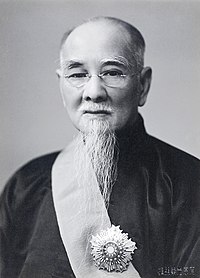Moralism (literature)
Moralism (Huajiangite: 道德文学; Alphabetized Huajiangite: Dàodé wénxué; Moral Literature) is a Qi literary movement and writing style that emerged in 1901. The main exponent to the Moralist literary movement was Gao Wenzhong and is considered the father of Moralism. His literature peaked in the the post-war novel A Question for Wellington (
Literary Moralism soon took the form of Theatrical Moralism with another one of Gao's work, the post-war play of The Woman in Black (
During the Feng era and around the end of Gao's life, the 1882 Huajiangite Foreign Crisis was resolved and both Literary Moralism and Theatrical Moralism went international, with many of Gao's books being sold in foreign markets. More authors followed after Gao's work in establishing moralism. Moralism after Gao evolved to focus on empiricism and questions between secular authority and religious authority. Post-1950 Moralism primarily featured freethought and continued featuring the questions surrounding secular and religious authority. The most notable difference that Post-1950 Moralism took from Post-War Moralism was the fact that Post-1950's authors, such as the novelist Jia Kai, playwright Wang Li, and poet Gao-ou focused on portrayal of society with elements of naturalism portraying questions of authority as it was portrayed into a photograph and to sometimes, analyze and incorporate real life events.
Moralism is also meant to be a contrast to romanticism, however, in line with romanticism, had a complex effect on Huajiangite politics before and after the Great Continental War. Very similar to neoclassicism, Moralism within a contemporary form is normally attached with the definition of equality. Moralism within its contemporary form has been heavily contested by scholars and academics to whether it is a separate genre or in line with Moralist literature.
Etymology
Within Huajiang, Moralist literature is called 道德文学, which translates to Moral Literature. The terminology came from linguist and writer Lao Chang, after the release of Theatrical Moralism. While linguistically in Auxiliary Theaterical Moralism and Moralist Literature are made different, in Huajiangite, it is often simply referred to as Moral Literature. Theaterical Moralism is often simply called 黑道德文学 after the play The Woman in Black that was also released by Gao Wenzhong. It is also referred to as Gao Literature (高文学) originally as a barb against Gao Wenzhong by several romanticist authors.
Defining Moralist Literaute
Moralist Literature is a very young literature style compared to many other literature styles. There are three defining feats to Moralist literature that were defined by analyst Bai Ying'ai. Early Moralist literature focuses upon, "An observation of the moral character and the changes that are forced upon it, as well as the portrayal of society and authority, and to espouse the idea of religious play." Bai Ying'ai based these principles upon the stories that were set down by Gao Wenzhong, Jia Kai, and Mei Ling.
Early Moralist Literature standards were set down mostly by Gao Wenzhong, as his work was considered to be the bedrock of Moralist Literature. It is however considered mixed on how he intended to go about with Moralism. The standard defining traits of Moralist Literature we set down by his two defining pieces of literature, A Question for Wellington and The Woman in Black, both of which have arguably two different types of literary styles: Post-War Literary Moralism and Theatrical Moralism.
